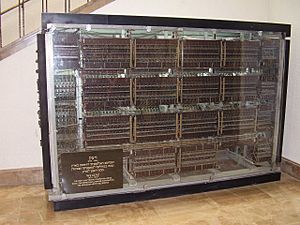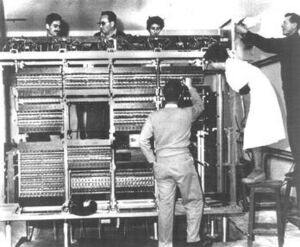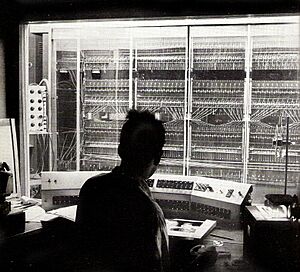WEIZAC facts for kids
The WEIZAC (which stands for Weizmann Automatic Computer) was a very important machine. It was the first computer ever built in Israel. It was also one of the first large, electronic computers in the world that could store its own programs.
This amazing computer was built at the Weizmann Institute of Science between 1954 and 1955. Its design was based on the IAS architecture, which was created by a famous scientist named John von Neumann. WEIZAC worked until the end of 1963. Many Israeli scientists and researchers used it. It helped a lot with science and technology in the young country of Israel.
Just like other computers from that time, WEIZAC was unique. It couldn't easily share programs with other computers, even ones that were similar to it.
Contents
How WEIZAC Started
The idea for WEIZAC came from Professor Chaim L. Pekeris. He worked at the Institute for Advanced Study (IAS) when John von Neumann was designing his computer. Chaim Weizmann, who would later become Israel's first president, asked Pekeris to start a new math department at the Weizmann Institute. Pekeris really wanted a computer like the IAS machine there.
He wanted to use it to solve complex math problems about the Earth's oceans. He also wanted it to help all scientists in Israel, including those working for the Defense Ministry.
The First Discussions
In July 1947, a special committee talked about the plan to build the computer. Albert Einstein was on the committee, but he didn't think it was a good idea. However, John von Neumann supported it. Someone once asked von Neumann, "What will that tiny country do with an electric computer?" He replied, "Don’t worry about that. If nobody else uses it, Pekeris will use it all the time!"
In the end, they decided to go ahead with the plan. Chaim Weizmann gave $50,000 for the project. This was a huge amount, about 20% of the Weizmann Institute's total budget!
Leading the Project
In 1952, Gerald Estrin was chosen to lead the project. He was a research engineer who had worked on von Neumann's computer. Gerald came to Israel with his wife, Thelma Estrin, who was also an electrical engineer and helped with the project. They brought the plans, but no parts.
Estrin later said, "If we had planned everything out in detail, we probably would have given up." When he arrived, Estrin felt that many Israeli scientists, except Pekeris, thought building a computer in Israel was a silly idea.
To find skilled people, they put an advertisement in the newspaper. Many applicants had lost their education records because of the Holocaust or during their move to Israel. But in Israel's growing tech community, everyone knew each other. The WEIZAC project also gave mathematicians and engineers a chance to move to Israel and continue their careers.
How WEIZAC Worked
WEIZAC was an asynchronous computer. This means it didn't rely on a constant clock signal for its operations. It worked with 40-bit words, which are like chunks of data. Its instructions were 20 bits long. Eight bits were for the instruction code, and 12 bits were for finding the data.
At first, it used punched paper tape to get information in and out. Later, in 1958, it started using magnetic tape. The computer's memory first used a magnetic drum that could hold 1,024 words. This was later replaced with a much faster magnetic-core memory that held 4,096 words. In 1961, the memory was made even bigger with two more 4,096-word modules.
What WEIZAC Was Used For
In late 1955, WEIZAC did its first calculation. After that, it was used to study many different problems. These included worldwide changes in tides, earthquakes, how atoms absorb light (atomic spectroscopy), and how crystals are structured (X-ray crystallography). It also helped with random walk methods and numerical analysis.
The computer discovered a special point in the South Atlantic where the tide doesn't change at all. It also calculated numbers for a quantum system with two electrons. These results were later proven correct by experiments at the Brookhaven National Laboratory. This showed that Schrödinger's Equations were right.
WEIZAC was always busy. Users, especially from other places, became frustrated because they couldn't get enough time on the computer. They wanted more computers to be available. WEIZAC's success showed that Israel needed computers and digital technology. This led to the start of Israel's computer and technology industries.
After WEIZAC
Until 1961, WEIZAC was the only computer in Israel. It worked until December 29, 1963. It was then replaced by a computer built by a company, called a CDC 1604A. At the same time, the institute's team started building their own computer called GOLEM. It was based on the ILLIAC II design but had many improvements. These changes made it much smaller and use less power.
WEIZAC's Recognition
On December 5, 2006, WEIZAC was honored by the IEEE. It was recognized as a major achievement in the history of electrical engineering and computing. The team who built it was given the "WEIZAC Medal."
See also
 In Spanish: WEIZAC para niños
In Spanish: WEIZAC para niños




